Contents
An interesting, unpretentious and rather beautiful plant, called broom, is gradually gaining popularity among gardeners. A perennial shrub, represented by more than 50 species, amazes with its beautiful flowering, causing admiration. Depending on the species, this plant may have a spreading or fluffy compact crown, mainly with rich yellow flowers. At the same time, this ornamental shrub attracts not only with its appearance, but also with the ease of cultivation. As a rule, planting and caring for a broom in the open field is not difficult, and the plant itself will delight with its lush greenery from early spring to late autumn.
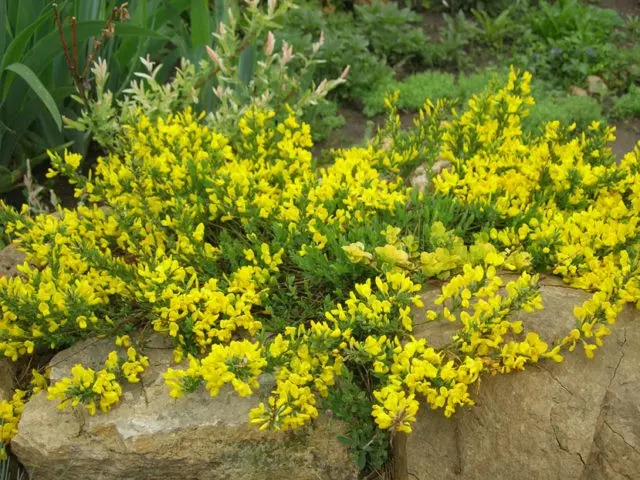
Features of growing rakidnik in the suburbs
Broom is a beautiful shrub related to legumes. Basically, this plant is deciduous, but there are also evergreen species. Shrubs are characterized by a lush crown with flexible branches and small foliage. Flowering is abundant and with a pleasant aroma.
Types of wild-growing broom are not resistant to frost, they begin to bloom in early spring. Flowers small, yellow. But since the natural conditions for this plant in the Moscow region are quite harsh, breeders bred hybrid varieties that combine the flowering of several species and resistance to various climatic conditions, including frost. It is the broom of these varieties that is recommended for cultivation in the gardens of the Moscow region.
Boskop Ruby – a hybrid variety with a lush spherical crown, reaching up to 2 m. It blooms in early May. Intense ruby-colored flowers.
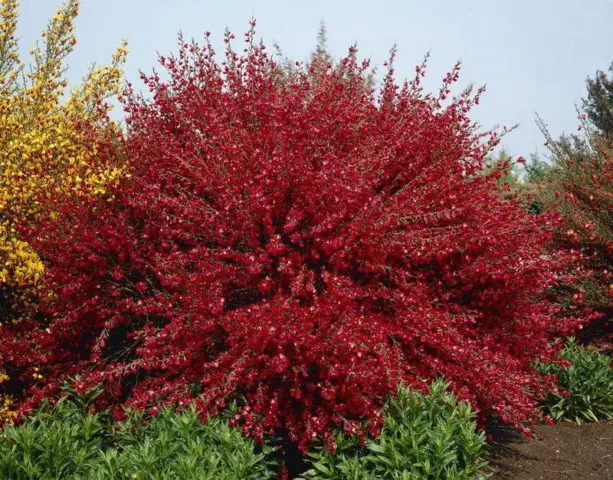
Albus – a frost-resistant variety that can tolerate frosts up to -40 ° C. The height of the bush is up to 1 m, the crown is dense with arched branches. Flowers are white.

Andreanus – a variety of broom, reaching up to 2,5 m in height. A distinctive feature is a pleasant aroma reminiscent of pineapple. Flowers bicolor red-yellow.
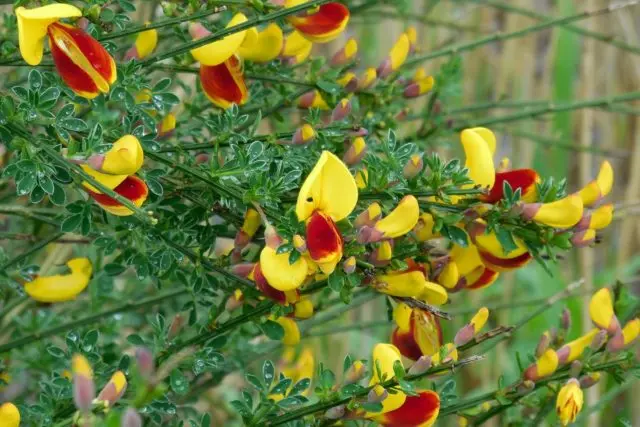
purple broom – low shrub, no more than 40 cm in height, with trifoliate leaves and delicate flowers of a purple-lilac hue.
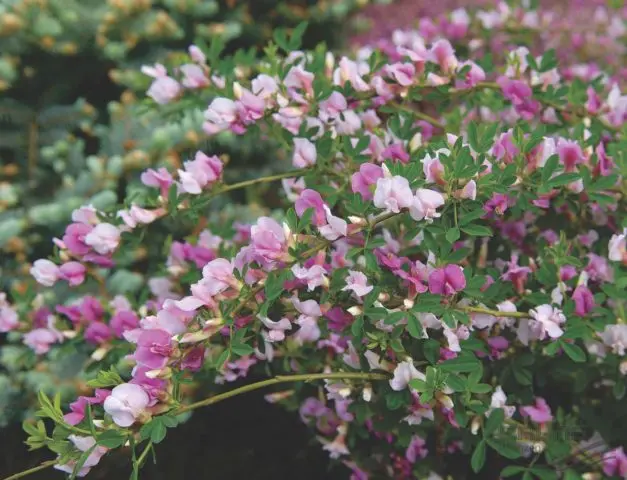
And the most common among species shrubs, which is well able to take root in the gardens of the Moscow region, is broom.

In fact, there are no special rules for planting and caring for broom and other varieties in the Moscow region, but there are a number of recommendations, following which this plant will delight with healthy flowering for many years:
- it is better to give preference to hybrid frost-resistant varieties;
- the landing site should be sunny, but sheltered from the winds;
- preparation for winter must necessarily include the shelter of a shrub, especially a young, recently planted broom;
- watering should be moderate and, as necessary, it is undesirable to flood the plant;
- it is necessary to carry out timely top dressing and loosening.
Planting and caring for a broom in the open field
Broom is a shrub rather unpretentious for planting and subsequent care, but it still takes root much better, develops and blooms on fertile, light soil in a warm and calm place.
The shrub itself is planted in early spring in late April or early May. Planting can be done with seedlings or seeds. The soil for planting should be sandy with a low acid content. The place should be sunny, warm and without through winds.
Preparation of planting material
The broom is planted in open ground as a seedling. At the same time, you can purchase a seedling already ready for planting or grow it yourself from seeds.
When purchasing a broom seedling, you need to make sure of the exact characteristics of this plant. The best option would still be to contact a specialized store, where all the necessary information will be provided to the selected seedling:
- variety;
- age;
- degree of frost resistance;
- manufacturing firm.
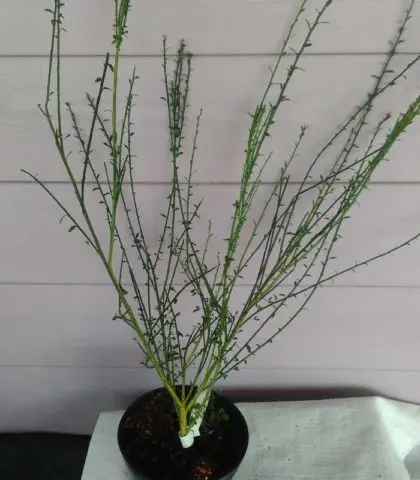
You can also sow broom seeds yourself. It is recommended to soak the purchased or collected seeds in warm water for 2 days before sowing.
After soaking, the seeds are sown in a container with moist peat-sandy soil to a depth of 0,5-1 cm. The seeds should be 4-6 cm apart from each other. After that, the container is covered with a film and placed in a warm, bright room with a temperature of about 21 ° C . Regular watering and spraying is mandatory.
After the appearance of seedlings with 2-3 fully formed leaves, the seedlings must be dived and transplanted into separate pots with prepared soil (2: 1: 0,5 – sod, humus and sand). Seedlings should be transplanted into open ground at the age of 3 years.
Site preparation
A place for planting a broom must be prepared in advance. The site should be sunny and slightly windy. The soil should be fertile, sandy, neutral or slightly acidic. If the soil is poor in nutrients, then it is advisable to apply complex mineral fertilizers.
The soil is dug up before planting. Holes are made, the depth of which should be several times greater than the volume of the root system of the seedling, together with an earthen clod. Be sure to drain the bottom of the pit with pebbles or stones. The heavier the soil, the thicker the drainage layer should be.
When planting several brooms, the distance between the planting pits should be at least 30 cm for small plants and 50 cm for tall shrubs.
Rules of landing
Proper planting of a broom seedling must be done in the following way:
- Prepare a landing pit, fill up the drainage layer.
- The seedling is placed exactly in the middle so that the root collar is at ground level.
- Then the broom is covered with soil mixture (a mixture of soddy soil, humus and sand 1: 1: 2), tamped around and watered abundantly (the root neck should also remain at ground level).
- It is also recommended to mulch the soil, which will ensure less evaporation of moisture and prevent the rapid growth of weeds.
Watering and top dressing
Watering and fertilizing the broom must be done in a timely manner. Water the shrub should be plentiful and as the top layer of soil around the trunk becomes completely dry.
But it is worth noting that an adult plant tolerates drought quite well. If it rains quite often in summer, then watering may not be required. It is more difficult for this plant to survive an excess of moisture than its lack.
After watering, it is necessary to loosen the soil and simultaneously remove weeds. Loosen the soil around the trunk should be to a depth of 12 cm.
For abundant flowering and growth, the broom also needs systematic feeding. The first feeding is carried out in the spring, and the second – in the middle of summer. In the spring, the bush is fed with fertilizers with a high nitrogen content, for this, a solution of urea is poured around the trunk (30 g per 10 liters of water). In the middle of summer, it is necessary to fertilize the plant with a top dressing containing phosphorus and potassium.
With the slow development of the bushes, additional feeding can be performed. Sprinkle no more than 300 g of wood ash evenly around the trunk circle.
Trimming
The broom does not need to form a crown. Pruning should be done only after flowering has ended to stimulate the formation of new shoots. At the same time, only some branches are removed to the lateral lignified strong branches.
Since broom contains the poisonous substance cytisine, pruning should be done with gloves to avoid burns.
Preparation for winter
Regardless of the fact that it is desirable to plant frost-resistant species of brooms in the Moscow region, there are still some tips that you need to know about preparing the plant for winter:
- A young bush needs shelter for the first 3 years. It is sprinkled with dry peat or earth. Then the branches are pulled together, tied to the top, and bent to the ground. Then covered with spruce branches, dry foliage or non-woven material.
- Undersized brooms also need to be covered for the winter with spruce branches or other covering material.
- Mature shrubs of 3 years or more do not need shelter.
Reproduction
Reproduction of broom can be carried out in 3 ways:
- seeds;
- cuttings;
- layering.
Collection of seeds for propagation is carried out in late August or early September, when the beans are fully ripe. They are planted in a container, covered with a film and put in a warm place with a temperature of up to 20 ° C. Periodically, seedlings open, ventilate and spray. The grown seedlings are transplanted to a permanent place in open ground no earlier than after 3 years.
Cuttings are carried out after the end of flowering with the help of semi-woody shoots, on which there should be at least 3-4 full leaves of medium size. They are cut and planted in a container. Each cutting is covered with a glass jar; airing and spraying is mandatory during rooting. In the spring, rooted cuttings are transplanted into open ground.
Reproduction by layering is carried out by bending the branches of the lower part of the shrub to the ground. The tops of the branches that touch the soil are fixed with special staples, then they are sprinkled with earth. When the cuttings begin to take root, they should be cut off, separated from the mother bush, and transplanted to another place.
Diseases and pests
The broom is a fairly resistant plant to pests and diseases, but still the shrub can cause great damage:
- Moth caterpillars – the larvae of this butterfly feed on the vegetative parts of the shrub, which can lead to its drying. To prevent the spread of the pest, broom should be sprayed with bacterial insecticidal or organophosphate preparations.
- Moth moth – destroys the green crown of the plant. Due to rapid reproduction, the broom can lose most of the leaves. A 2% solution of Chlorophos will help get rid of the pest.
The following diseases should also be distinguished:
- powdery mildew;
- black spotting.
When the first signs of these diseases appear, the broom should be sprayed with a solution of 5% copper sulfate. With extensive damage, it is recommended to use potassium sulfur or Fundazol.
Conclusion
Planting and caring for a broom in the open field, in the Moscow region, is not particularly different from growing this plant in other regions. The only thing to consider is the frost resistance of the shrub, so it is recommended for this area to choose exactly those varieties that can withstand negative temperatures.









